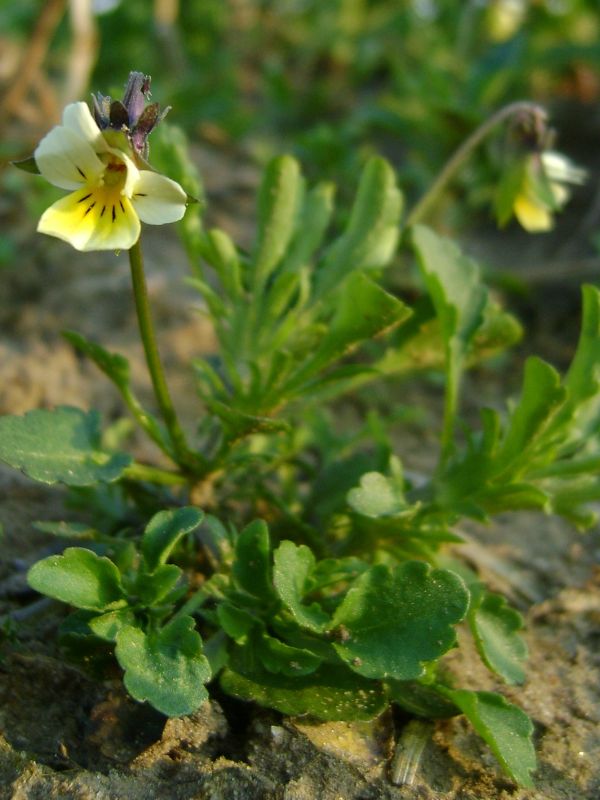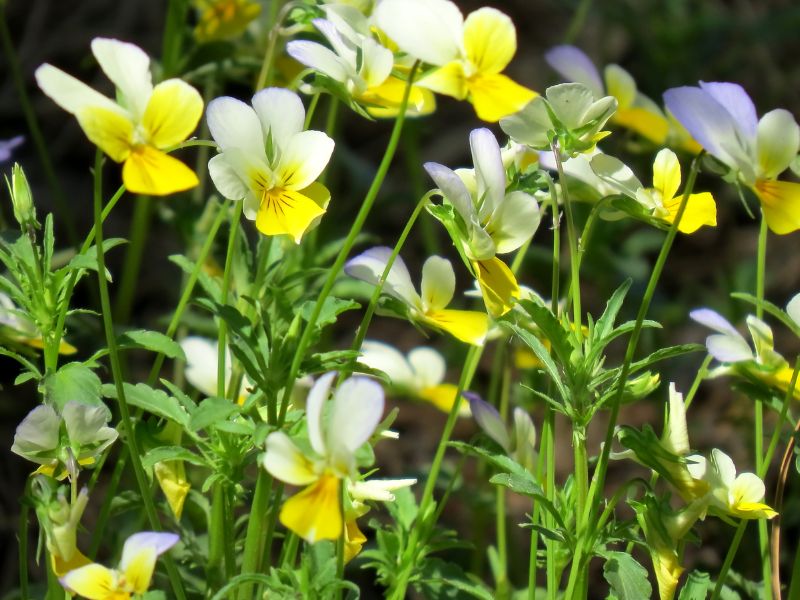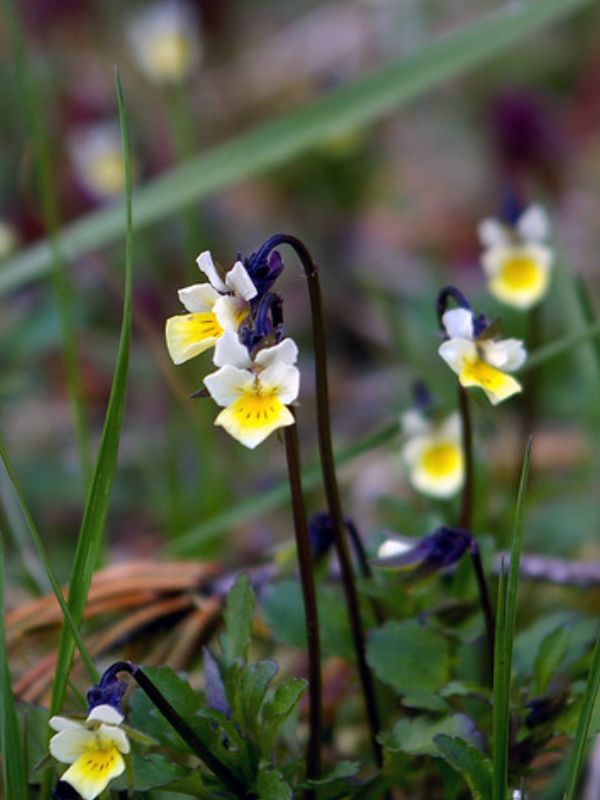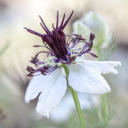The European Field Pansy (Viola arvensis), also known as Field Pansy, Wild Pansy, or Johnny Jump-up, is an annual plant belonging to the Violaceae family. Native to Europe, Western Asia, and North Africa, this winter annual is often mistaken for the common violet due to its lobed leaves and delicate flowers. Its small, long-stalked blooms can range from violet to cream in color, adding a subtle charm to its surroundings.
While its appearance might appeal to some, the field pansy is frequently regarded as a challenging broadleaf weed. Controlling it can be difficult, as it shows resistance to many herbicides. This plant’s dual identity as both a pretty flower and a stubborn weed has made it a subject of interest for gardeners seeking effective management solutions. Read on for detailed information about the field pansy, its characteristics, and care tips.
| Common name | European Field Pansy, Field Pansy, Field Violet, Johnny Jump-up, Violets, Wild Pansy |
| Botanical name | Viola arvensis |
| Family | Violaceae |
| Species | cornuta |
| Origin | Europe, Western Asia, and North Africa |
| Life cycle | Annual |
| Plant type | Annual |
| Hardiness zone | 6, 7, 8, 9 |
| Sunlight | Full Sun |
| Maintenance | Medium |
| Soil condition | Clay |
| Soil ph | Acid |
| Drainage | Well-Drained |
| Growth rate | Medium |
| Spacing | 12 in. – 3 ft. |
| Flowering period | Fall |
| Flower color | Gold, Yellow |
| Leaf color | Green |
| Fruit type | Capsule |
| Flower benefit | Fragrant |
| Garden style | Butterfly Garden |
| Uses | Container |
I. Appearance and Characteristics
Viola arvensis is a species of violet known by the common name field pansy. It is native to Europe, western Asia, and North Africa, and it is known on other continents as an introduced species and a weed of disturbed and cultivated areas.
Viola arvensis was shown to contain cyclotides, a class of peptides found in plants. The peptide cycloviolacin O2 in particular has shown to possess cytotoxic activity against human cancer cells and is therefore looked at as a potential drug lead.
It is an herbaceous annual plant with serrated leaves, and usually flowers with white all over, except the bottom petal (Although there are actually flowers with a tinge of purple at the top) and dehiscent capsules. It reproduces by seed. It grows 20 centimeters tall.

The field pansy is reported to be slightly toxic when ingested in large amounts. Reportedly, the poisonous parts of the field pansy are seeds. Eating the seeds in large quantities can cause minor illnesses, manifested primarily by low to moderate gastric disturbances (vomiting, diarrhea, nausea, and stomach cramps).
Since the field pansy, as well as many Viola species, are commonly cultivated in gardens, special caution is always advised with this plant, as it may look tempting to eat. Extra caution is needed with children who may find the Viola blossoms attractive to put in their mouths.
II. How to Grow and Care
Sunlight
Originating from temperate regions, field pansy is accustomed to moderate moisture levels and can tolerate brief periods of dryness. This resilience is a reflection of its ability to adapt to the varying water availability in its native habitat. In cultivation, field pansy thrives with consistent hydration, benefiting from watering every week to maintain soil moisture without becoming waterlogged.
As an herbaceous plant often found outdoors, field pansy’s growth cycle is closely tied to rainfall patterns, requiring more frequent watering during prolonged dry spells to mimic its natural environment.

Temperature
Field pansy is cold-resistant and moderately heat-resistant. Generally speaking, it flowers from spring to fall. Quantity of flowers may decrease in high temperatures. It can tolerate light frost and snow cover in winter. If grown in a cold region, it should be kept warm in winter. In a word, it should be protected from high temperature and humidity in summer, and have less water in winter during its dormancy.
Watering
Originating from temperate regions, field pansy is accustomed to moderate moisture levels and can tolerate brief periods of dryness. This resilience is a reflection of its ability to adapt to the varying water availability in its native habitat. In cultivation, field pansy thrives with consistent hydration, benefiting from watering every week to maintain soil moisture without becoming waterlogged. As an herbaceous plant often found outdoors, field pansy’s growth cycle is closely tied to rainfall patterns, requiring more frequent watering during prolonged dry spells to mimic its natural environment.
Soil

Field pansy likes moist, well-drained, air-permeable soil. A small amount of substrate, such as perlite, ceramsite, and vermiculite, can be added to the soil when planting.
Fertilizing
Common slow-release commercial compound fertilizers can be used for field pansy. During the growth and bloom time, thin compound liquid fertilizer can be applied once every two weeks. For specific application methods, please refer to the product specifications of the compound fertilizers.
Planting Instructions
Although it is a perennial plant, field pansy is usually replanted every year. Sow it from late fall to early spring of next year, and flowers will come in about two months after sowing. Try to choose a cool environment. Sprinkle seeds directly on the surface of the soil, and cover them with a thin layer of soil.

To sow indoors, wrap the seeds in a wet paper towel. Pack the paper-wrapped seeds into sealed bags or other containers and put them in the refrigerator or refrigerating chamber for 3-4 days to accelerate germination.
After the seedlings germinate, remove the top buds to facilitate the growth of lateral buds. This prevents seedlings from getting floppy and spindly, supports the plant shape, and increases the quantity of flowers. If the seedlings bloom early, early-blooming flowers can be removed so the plants accumulate energy to bloom more.
Propagation
Some varieties of field pansy are self-pollinated. They will bear fruits after flowering, and the ripe fruit will split into three petals. At this time, the seeds can be collected for sowing in the following year.
III. Uses and Benefits
Fresh field pansy’s flowers can also be picked to decorate dishes, as they are edible.
IV. How to Control

Tilling is a good field pansy control, and the plants are only a serious problem for those raising crops that are not tilled. These include cereals and soybeans. The speed of germination and growth does not help gardeners intent on controlling field pansies’ spread.
Those intent on field pansy control have found that certain chemicals are helpful. Consult with your local extension service agent or garden center for instructions and safe use of chemicals if you choose to use them on field pansies.
Note: Chemical control should only be used as a last resort, as organic approaches are safer and much more environmentally friendly.
Find Where to Buy the Best European Field Pansy (Viola arvensis)














Leave a Reply